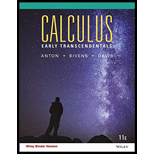
Suppose that a curve C in the
(a) Let m and M denote the respective minimum and maximum values of
(b) Use part (a) to prove that max
Want to see the full answer?
Check out a sample textbook solution
Chapter 15 Solutions
CALCULUS EARLY TRANSCENDENTALS W/ WILE
Additional Math Textbook Solutions
Thomas' Calculus: Early Transcendentals (14th Edition)
Calculus and Its Applications (11th Edition)
Precalculus (10th Edition)
University Calculus: Early Transcendentals (4th Edition)
Glencoe Math Accelerated, Student Edition
- 1. A function of two variables is given f(x, y) = x² + y² + e-(x²+y²) a) Draw a picture of the graph of the function f. Use for example Geogebra. b) Find a tangent plane to the graph of the function f at all points (x, y, f(x, y)) c) At what points is the tangent plane parallel to the xy-plane? How does the function behave near the points (0, 0)?arrow_forward13. Find an equation for the tangent plane of the graph of f at the point (xo, yo, f(xo, yo)) for: (a) ƒ: R²2 → R, (x, y) → x − y +2, (xo, yo) = (1, 1) (b) (c) ƒ: R² → R, (x, y) ↔ x² + 4y², (xo, yo) = (2, -1) f: ƒ: R² R, (x, y) → xy, → (xo, yo) = (-1, −1) (d) f(x, y) = log (x + y) + x cos y + arctan(x + y), (xo, yo) = (1, 0) -2 (e) f(x, y) = √√√x² + y², (f) f(x, y) = xy, (xo, yo) = (1, 1) (xo, yo) = (2, 1)arrow_forwardSketch the following sets of points in the x-y plane. {(x, x^2): x is in R}arrow_forward
- Answer the question:arrow_forwarda) Find the directional derivative of the function f(x, y, z) = x² y? (2z+1)² at the point P:(1, – 1, 1) and in the direction of a =[3, 3, 0]. b) Find the direction of maximum decrease of f at the point P. Maximum file size: 100MB. maximum number of files: 1arrow_forwardFind the maximum value of of Iƒ" (x) [0,2] f(x)=√1+x² HINT: Much like the previous question except that you are focussing only on the max. Input your function as surd((1+x^2),2); Let your second derivative function equal abs(df2); assuming that df2 is the second derivative. Substitute your endpoints 0 and 2 into your absolute value second derivative function. Find third derivative and solve it for x. Substitute the result obtain into your second derivative absolute value function. Compare all y-values obtained for maximum value. 5) on the indicated interval. 6) Without the aid of a graph, find the absolute maximum and minimum values of the functionarrow_forward
- 6. (a) Let I be an interval and ~r₁(t) = (x₁(t),y₁(t),z₁(t)) where t€ 1, be two differentiable curves in R³ Show that i. ii. and ~r₂(t) = (x₂(t),y₂(t),z2(t)), d (F₁(t) · F₂(t)) = ri(t) · F₂(t) + Fi(t) · F₂(t) dt d dt (b) * Suppose that I is an interval and (Fi(t) × F₂(t)) = T₁(t) × ²₂2(t) + r₁(t) × F2(t) X ~r(t) = (x(t),y(t),z(t)), where t € I, is a twice-differentiable curve that describes the position of an object in R³. If the object is moving at a constant speed, show that its velocity is always perpendicular to its acceleration.arrow_forwardAsaparrow_forward
 Calculus: Early TranscendentalsCalculusISBN:9781285741550Author:James StewartPublisher:Cengage Learning
Calculus: Early TranscendentalsCalculusISBN:9781285741550Author:James StewartPublisher:Cengage Learning Thomas' Calculus (14th Edition)CalculusISBN:9780134438986Author:Joel R. Hass, Christopher E. Heil, Maurice D. WeirPublisher:PEARSON
Thomas' Calculus (14th Edition)CalculusISBN:9780134438986Author:Joel R. Hass, Christopher E. Heil, Maurice D. WeirPublisher:PEARSON Calculus: Early Transcendentals (3rd Edition)CalculusISBN:9780134763644Author:William L. Briggs, Lyle Cochran, Bernard Gillett, Eric SchulzPublisher:PEARSON
Calculus: Early Transcendentals (3rd Edition)CalculusISBN:9780134763644Author:William L. Briggs, Lyle Cochran, Bernard Gillett, Eric SchulzPublisher:PEARSON Calculus: Early TranscendentalsCalculusISBN:9781319050740Author:Jon Rogawski, Colin Adams, Robert FranzosaPublisher:W. H. Freeman
Calculus: Early TranscendentalsCalculusISBN:9781319050740Author:Jon Rogawski, Colin Adams, Robert FranzosaPublisher:W. H. Freeman
 Calculus: Early Transcendental FunctionsCalculusISBN:9781337552516Author:Ron Larson, Bruce H. EdwardsPublisher:Cengage Learning
Calculus: Early Transcendental FunctionsCalculusISBN:9781337552516Author:Ron Larson, Bruce H. EdwardsPublisher:Cengage Learning





